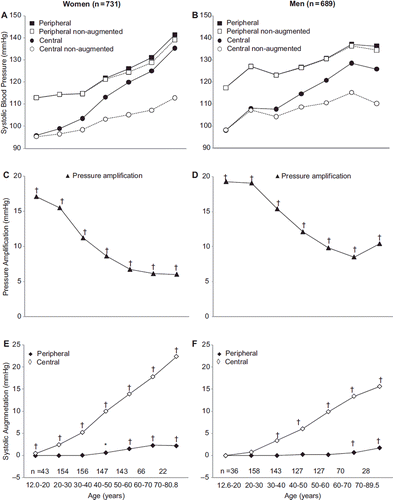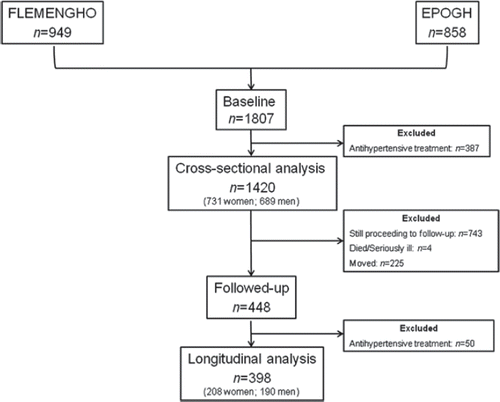Figures & data
Table I. Baseline characteristics of participants by study phase and sex.
Figure 2. Association with age of peripheral and central systolic blood pressures (A,B), peripheral and central non-augmented systolic blood pressures (A,B), pressure amplification (C,D), and peripheral and central systolic augmentation (E,F) in women (A,C,E) and men (B,D,F). Peripheral systolic blood pressure was the average of three blood pressure readings at the brachial artery. Central systolic blood pressure was the maximum pressure of the central waveform. Systolic augmentation was obtained by subtracting the first systolic peak from systolic blood pressure. Pressure amplification is peripheral minus central systolic blood pressure. Plotted values are means for each age group. Numbers indicate the subjects contributing to the group means. All p-values for trend with age were statistically significant p<0.0001). Significance of the difference with zero: *p<0.05, †p<0.001.

Figure 3. Blood pressures at baseline and follow-up by sex and quarters of the age distribution. Plotted values are peripheral and central systolic blood pressures (A,B), pressure amplification (C,D), and peripheral and central systolic augmentation (E,F) in 208 women (A,C,E) and 190 men (B,D,F). All p-values for trend with age were statistically significant (p<0.01). Significance of the difference between baseline and follow-up: *p><0.05, †p><0.01, ‡p< 0.001.

Table II. Cross-sectional association of blood pressure with age and longitudinal change in blood pressure with ageing in women and men.
Table III. Longitudinal changes in blood pressure by quarters of the distribution of peripheral systolic blood pressure at baseline in women and men.
Table IV. Correlates of peripheral and central systolic blood pressures in women and men.
